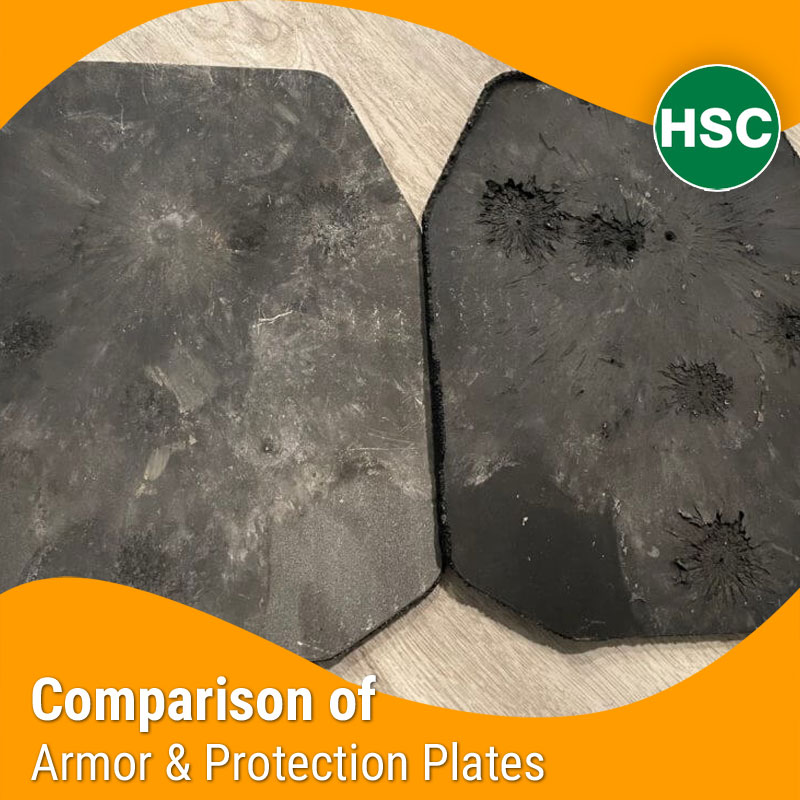When buying armor steel plates, one of the most important things to understand is:
“How is the ballistic performance of armor plates tested?”
At Hindustan Steel Corporation, we help clients select HIND ARMOR 500, HSC 500T, or MIL-DTL / STANAG equivalent plates, based on verified ballistic test results like V50 and V0 values.
Let’s break down both testing terms in simple, buyer-friendly language.
What is V50 Ballistic Test Value?
V50 means the velocity at which 50% of the shots penetrate the armor plate and 50% do not.
It is used to determine the ballistic limit of a steel plate.
| Parameter | Explanation |
|---|---|
| Test Type | Multiple shots at increasing/decreasing velocities |
| Outcome | Velocity where penetration chance is 50% |
| Standard | MIL-STD-662F (commonly used in defense testing) |
V50 helps manufacturers and buyers understand at what speed the plate starts failing against a specific threat.
What is V0 Ballistic Test Value?
V0 means the maximum velocity at which 0% of projectiles penetrate the plate.
| Parameter | Explanation |
|---|---|
| Test Type | Repeated shots below failure velocity |
| Outcome | All projectiles stopped at given velocity |
| Common Use | NIJ and MIL-DTL performance standards |
V0 is considered a more conservative, safety-focused ballistic performance measure.
Key Difference Between V50 and V0 Tests
| Factor | V50 | V0 |
|---|---|---|
| Failure Point | 50% shots fail | 0% shots fail |
| Usage | Research and manufacturing | Field acceptance and certification |
| Safety Margin | Lower | Higher |
| Required for Defense Contracts | Often both | Often both |
Which Standards Specify V50 or V0 Testing?
| Standard | Test Type |
|---|---|
| MIL-DTL-46100 / 12560 | Both V50 and V0 |
| STANAG 4569 | V50 |
| NIJ Level III/IV | V0 |
| EN 1522 FB6/FB7 | V0 |
At Hindustan Steel Corporation, we help buyers choose armor plates with test reports aligned to these standards.
Typical V50 & V0 Values for Armor Plates
| Grade | Approximate V50 (m/s) | Approximate V0 (m/s) |
|---|---|---|
| HIND ARMOR 500 (10 mm) | 850–900 m/s | 800–850 m/s |
| MIL-DTL-46100 (10 mm) | 850–900 m/s | 800–850 m/s |
| MIL-DTL-12560 (12 mm RHA) | 600–650 m/s | 550–600 m/s |
Note: Actual values depend on plate thickness, threat caliber, and test lab conditions
How Are V50 and V0 Tests Conducted?
- Test Setup: Armor plate fixed on frame
- Threat Selection: Specific caliber, velocity, and shot distance
- Shot Sequence: Multiple shots at varying speeds
- Result Recording: Penetration or no penetration after each shot
- Reporting: Certified lab report with photos and data
We coordinate third-party ballistic testing for project-based requests.
Why V50 and V0 Results Matter for Buyers
- Proof of plate’s real-world performance
- Required for government defense tenders
- Helps buyers select correct thickness and grade
- Gives confidence during fabrication and field deployment
Hindustan Steel Corporation’s Testing Support
- In-house hardness and quality tests
- Third-party ballistic lab coordination
- Sample plates for destructive testing
- V50 and V0 data available for HIND ARMOR 500 and HSC 500T (on request)
- Custom testing based on your project threat level
Related Grades Available with Test Support
- HIND ARMOR 500
- HSC 500T Tactical Armor
- MIL-DTL-46100 Equivalent Plates
- STANAG 4569 Level Steel
- EN 1522 FB6/FB7 Equivalent
Export Support for Ballistic-Tested Plates
We export V50/V0-tested armor plates to:
- UAE
- Saudi Arabia
- South Africa
- Europe
- Africa
Packaging Includes:
- Seaworthy export packing
- VCI wrapping
- Heat number and lot marking
- Test reports attached for export clearance
Ordering Plates with V50/V0 Certification
- Mention your required threat level (caliber and velocity)
- Confirm need for third-party lab testing
- Plan extra lead time if lab testing is required before dispatch
- Ask for previous batch test data (for quick reference)
- For urgent projects, opt for ready stock with previous test history
Certifications, Testing, and Documentation
Mill Test Certificate (MTC)
Hardness Test Reports
Ballistic Test Reports (V50 / V0)
Third-Party Inspection Certificates
Ballistic Compliance Declarations (on request)
FAQs: V50 & V0 Armor Testing
What is V50 ballistic test in armor steel?
Velocity at which 50% shots penetrate, 50% don't.
What is V0 in armor testing?
Velocity where 0% projectiles penetrate.
What’s the main difference between V50 and V0?
V50 = 50% failure point, V0 = zero failure point.
Is V50 required for defense tenders?
Yes, often.
Which is safer: V0 or V50?
V0 is more conservative and safety-focused
Do Hindustan Steel Corporation plates have V50/V0 test reports?
Yes, on request.
Are both tests done on every order?
Only if requested by the buyer.
How long does it take to get plates with fresh ballistic testing?
1–2 weeks additional lead time
Do Indian defense projects require V0 reports?
Yes, in many cases.
What standards specify V50 and V0 testing?
MIL-DTL-46100, STANAG 4569, NIJ, EN 1522
How do I order V50/V0 tested plates?
Call, email, or WhatsApp with project details and test level required.
Need V50 or V0 tested armor plates for your defense or infrastructure project?
Contact Hindustan Steel Corporation today
Ask for:
- Grade-wise V50/V0 data
- Pricing for tested plates
- Sample test plates

